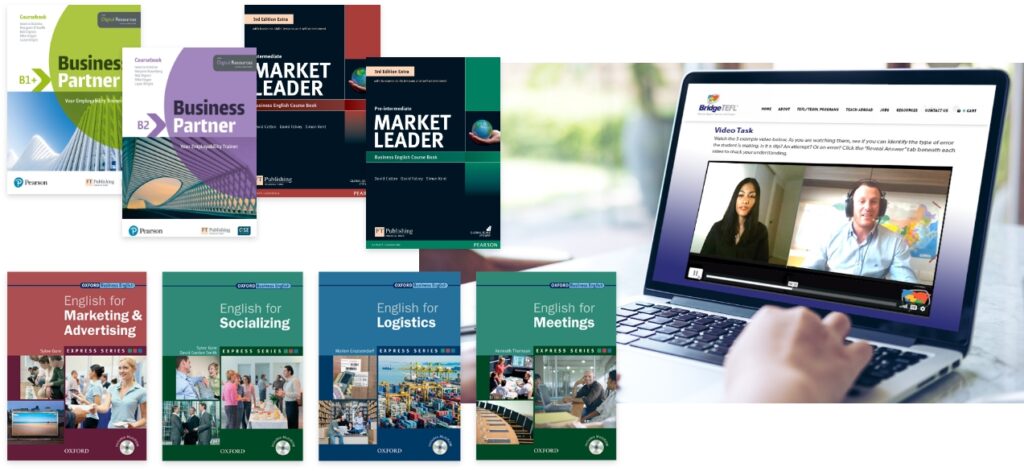Learning a new language is difficult at any point in a person’s life, but adult learners are often faced with additional challenges. Identifying the common challenges for Business English learners will provide insights into the right resources and support to overcome the challenges of learning a new language. Here are seven of the most common Business English learning challenges and solutions that can improve the effectiveness of your corporate language program.

1. Staying motivated
Solution: While there is no one-size-fits-all solution for keeping your language learners motivated, especially in a demanding professional environment, a teacher-centric program is proven to best engage and motivate students.
A teacher-centric program is one that leverages a personal rapport between the instructor and students. This form of program encourages relationship-building which in turn promotes accountability and a culture of learning. When a corporate language program incorporates live instruction, guidance or tutoring opportunities arise for live practice and on-the-fly feedback. Teacher-centric programs that incorporate state-of-the-art technology such as Bridge’s learning platform are often most effective, combining rapport with live teachers and the flexibility and ease of use of an online platform with online learning, scheduling, video conferencing, and program management.
If motivation seems to be an ongoing issue with employees in your language training program, you may need to conduct an audit of the current learning environment. Is the material presented solely through recordings or written material? Do your students lack personal engagement with other learners or an educator? Feelings of isolation are often a significant contributor to a decrease in learning performance.
2. Getting in the learning mindset
Solution: An employee’s learning environment will often be filled with distractions but a defined learning space can help. From emails and meetings to balancing daily tasks, employees learning a language will often have a hard time settling into the learning mindset. This shift from professional to student is a difficult transition. The best way to resolve this challenge is to create a dedicated learning space in the office. Encourage employees to create a similar space at home, especially if they are remote workers or working on a hybrid schedule. Here are some tips for creating a functional and affordable learning space, either at the office or at home.
- An ideal learning space is quiet and distraction-free. The room should be well-lit and private.
- A desk, table, or another flat workspace should provide enough room for a laptop, notes, and learning materials.
- A stable Wi-Fi connection with internet access that meets bandwidth requirements for streaming and video conferencing is critical for accessing learning materials and support.
- If in-person instruction or tutoring is taking place, ensure there is space for a whiteboard or other display methods such as an easel or projection screen.
- Some available office supplies such as pens and paper go a long way in helping a learner feel comfortable and prepared to settle in for a lesson.
Creating a comfortable learning space doesn’t require high-tech investments or large purchases. A quiet, comfortable dedicated learning space for students will encourage a learning mindset.
3. Finding the time to learn
Solution: Finding the time to learn goes hand in hand with establishing the learning mindset, but flexible course scheduling options can help. With high-priority job duties, it can be difficult to find time to complete language course tasks. The solution for the time issue is simple: choose a language program with flexible scheduling. Each language learner will have different hours of availability and each student will learn best at different times of day. Providing employees with the flexibility to learn when they are able to focus will help them fit the program into their busy lives.
Working with a corporate language partner that has flexible scheduling options and providing designated learning time to employees will reduce the challenge of finding time for language learning. Any corporate language program is an investment; supporting employees by designating time and resources that will aid learning successes will ensure a return on that investment.
Learn more about BridgeEnglish language programs and scheduling solutions.
4. Having unrealistic expectations of how long it takes to learn a language
Solution: For management teams around the world, the phrase “expectation management” is intrinsically linked with constant re-evaluation. Learning a language takes time, but understanding it’s a long process and providing opportunities for additional practice can help. Managing the expectations of leadership and employees will be a significant factor in long-term repeatable successes with corporate language programs. Many people who have never tried to learn a new language may have unrealistic expectations of how quickly they will become proficient. In some cases, implementing a language program into a corporate structure may be a new practice.
It’s important that all parties keep in mind that learning any language simply takes time. Many language program experts say that it takes about 1000-1200 hours of study to become fully fluent in English. For many students, the path to language learning becomes a lifelong journey. Bridge clients are often students for years, earning additional credentials as their experience and proficiency levels evolve with their careers.
Here are a few methods to suggest to employees for practice outside of their structured courses:
- Join a round table discussion group to practice speaking or job-skill tasks.
- Download a language app, such as Mondly, by Pearson, to practice outside of class.
- Listen to English language radio, or watch TV shows and movies in English with subtitles.
- Download a bilingual podcast to get a feel for code-switching and seamlessly integrating multiple languages into audio content.

The Bridge language program offers access to round table workshops to practice conversation and other job-related tasks. Contact us to learn more!
5. Feeling frustrated by lack of progress
Solution: Students and human resources teams feeling frustration with learning progress is a very normal part of the language learning process, but access to detailed learning metrics that show micro-progressions can be encouraging. Learners and program managers benefit from tools and metrics that measure students’ progress. The solution to avoiding these frustrations is to find a program that uses an effective tool to evaluate language proficiency test results, particularly one that shows the nuanced progress of each learner. Bridge uses the Global Scale of English, or GSE. This progress measurement tool was developed by Pearson and is based on the Common European Framework for Reference (CEFR). The CEFR is used with language proficiency exams around the world and is widely accepted as a measurement of English language proficiency. However, it uses six broad scales of measurement. The GSE uses a scale of 10-90, based on the CEFR’s six scales, and can show micro-progressions between each level, detailing progress in a nuanced way.
6. Lacking effective support systems
Solution: There are numerous ways companies can support their language learners on their path to success. From creating a comfortable learning environment to conducting effective routine training evaluations, there are many ways to stay involved in the learning process and ensure employees are maximizing their potential. Partnering with an English language trainer with built-in systems of support can streamline this process. The Bridge program management platform is a great example, with an innovative Language Performance Indicator (LPI) dashboard that provides analytics with information on a range of resources, such as personalized course data, self-study lessons, and live tutoring tracking, as well as meaningful downloadable reports. Bridge also tailors Learning Paths for students, helping learners specialize in their industry and focus on the competencies they will encounter within their daily roles.
Support comes in many forms. From one-on-one tutoring opportunities to customizing course offerings, the Bridge support system integrates with company Learning and Development programs to support all aspects of the language program.

7. Finding the right course format
Solution: Lastly, it’s important to take a look at the overall format of the language program structure. Every company will have different requirements and so will each learner. It’s important to find a program that has options. Some learners work well with self-paced online work. Others will require more traditional instruction. Bridge offers private, small group, and full-immersion formats. Regardless of which format your company works with, it is important to ensure that collaboration, discussion, and routine evaluations are a part of the program.
There are so many benefits to incorporating an English language training program into an international business model. Being aware of the common challenges for Business English learners can help you prepare to mitigate those difficulties with effective solutions. Partnering with a language program trainer with built-in systems for flexible scheduling and progress tracking that uses a teacher-centric model coupled with state-of-the-art technology solutions will improve learner outcomes and ensure your program sees individual and company-wide success.










